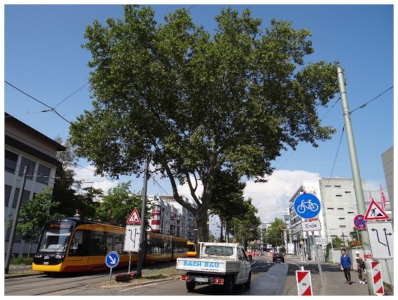Selection tool for urban trees
Rising temperatures and an increase in weather extremes as a result of climate change pose special challenges for municipalities and their urban trees. Tree species that have long been a feature of our urban landscape are clearly showing the traces of climate change: drought stress and increased susceptibility to diseases and pests are no longer uncommon. This is where the CityTreeSuit project by the FVA comes into play.
The aim is to support municipalities in the site- and climate-specific selection of urban tree species. To this end, researchers in the project have developed an online decision-making tool. It creates a tree species ranking list with recommended candidates for the respective site characteristics. Twenty tree species, ranging from sweetgum and field maple to Hungarian oak, are available for selection. Municipalities can influence the result through three questions – for example, whether the trees should be in green spaces or along streets, and whether aesthetics, cost-effectiveness, or human health should be prioritized in the selection. The result is a selection of profiles for suitable tree species, helping municipalities to determine what tree species will be suitable for the future and what alternatives are available.
In order to meet the different requirements placed on urban trees, a multi-criteria procedure has been used. In addition to climatic aspects, other criteria relevant to cities - such as allergy potential or tolerance to road salt - were considered for the suitability assessment of urban trees. For the development of this decision tool, existing tools for determining the suitability of different tree species for urban areas are taken into account. These include the Climate Species Matrix (KLAM), the citree planning database of the Technical University of Dresden, and the street tree list of the German Conference of Garden Authorities. In addition, a new literature study especially with regard to ecosystem services was carried out. Furthermore, the scientific findings from GrüneLunge 1.0 were incorporated. For example, urban trees in Karlsruhe were studied in terms of their ecosystem services and their effect on human health as part of the project. We were also able to determine the growth potential of various tree species based on site conditions and extreme weather events.
To consider municipality-specific requirements, the individual criteria were weighted according to their importance with the help of test communities. Subsequently, scenarios were created that take regional characteristics or individual requirements into account when selecting tree species. Such prioritizations, also known as preference articulations, may include drought tolerance, shade, irrigation, or even human health. The close cooperation with the Working Group on Urban Trees of the German Conference of Garden Authorities was also essential for the creation of the planning tool. The outcome of this subproject is a tool that has been expanded to include several criteria and further refined to incorporate methodological aspects, thereby supporting the complex decision-making process of selecting tree species in urban areas under climate change.
.png)

